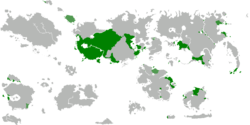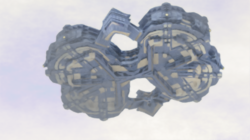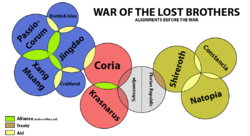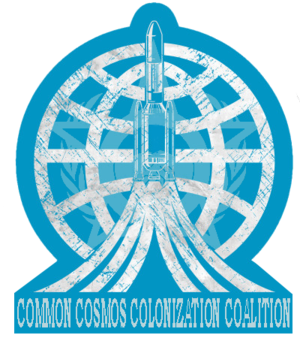Union of States around the Sovereign Oceans: Difference between revisions
mNo edit summary |
m (→Full Members) |
||
| Line 124: | Line 124: | ||
| | | | ||
*Founder of the USSO Common Market. | *Founder of the USSO Common Market. | ||
|- | |- | ||
|- bgcolor="#e6e9ff" | |- bgcolor="#e6e9ff" | ||
| Line 148: | Line 139: | ||
| 159,255,163 | | 159,255,163 | ||
| | | | ||
|- bgcolor="#e6e9ff" | |- bgcolor="#e6e9ff" | ||
| [[File:Palesmeniaflag.png|25px]] [[Palesmenia]] | | [[File:Palesmeniaflag.png|25px]] [[Palesmenia]] | ||
| Line 158: | Line 147: | ||
|- bgcolor="#e6e9ff" | |- bgcolor="#e6e9ff" | ||
| [[File:Lengflag2.png|25px]] [[Iron Cult of Leng]] | | [[File:Lengflag2.png|25px]] [[Iron Cult of Leng]] | ||
| | | 1683 AN (April 6, 2020) | ||
| Full Member | | Full Member | ||
| 57,500 | | 57,500 | ||
| | | | ||
|- | |||
|- bgcolor="#e6e9ff" | |||
| [[File:Leylstadt_flag.png|25px]] [[Duchy of Leyl]] | |||
| 1683 AN (April 9, 2020) | |||
| Full Member | |||
| | |||
| | |||
*Not yet active in the USSO Common Market. | |||
| | |||
|- bgcolor="#e6e9ff" | |||
| [[File:Flag_barbary.png|25px]] [[Barbarian Republic]] | |||
| 1686 AN (July 19, 2020) | |||
| Full Member | |||
| | |||
| | |||
*Not yet active in the USSO Common Market. | |||
|} | |} | ||
Revision as of 14:02, 19 July 2020
| Union of States around the Sovereign Oceans | |||
| |||

| |||
| Headquarters | USSO Command Enterprise | ||
| Official language(s) | English | ||
| Type | Political, military and economic union | ||
| Leaders | |||
| - Chairman of the USSO | Kan Zen | ||
| - Executive branch | Union Council of Commissars (UCC) | ||
| - Main assembly | Political Consultative Committee | ||
| Establishment | 13.XIII.1645 AN (26th February, 2017) | ||
| Membership | 6 member states,
1 associate member, 2 observers (of 54 MCS-nations [1]) | ||
| Organisation website | NA | ||
| Organisation forum | Forum | ||
The Union of States around the Sovereign Oceans (USSO) is a collective defence, economical and cultural treaty organisation among Jingdaoese Empire, Passio-Corum, Xang Muang, Alrig and Krasnocoria. It has an estimated population of over 600 million citizens (more or less 34% of the world's population) and holds land on almost every continent across Micras. While originally established as a defensive alliance to counter (in its eyes, perceived) aggressive actions of a Shirerothian-Natopian axis, the focus and input from Passio-Corum swayed its members to establish and further integrate a common market between the members. It eventually developed into an economic, defensive and cultural union between very diverse states.
The Union itself traces its roots back in the Hammish Civil War, in which several of the founding states saw the interference of the Shirerithians in the civil war as very worrisome. Soon after, the alliance also began cooperating on the economical, cultural and scientific level. Since the Union Treaty of 1649, all citizens of each Union State can also apply for Union Citizenship, which guarantees free movement between the States.
History
Origin: the Hammish Civil War
The USSO was born during a period of heightened tensions due to the ongoing Hammish Civil War. Jingdao, which had undergone a change of government and (limited) liberalisation after the death of the Sheng Emperor, sought to regain some influence on the world stage. Its Blackrock Pact had also fallen apart and at the same time, serious concerns existed on the increased presence of Natopian and Shirerithian colonies on Apollonia, which it saw as its own sphere of influence.
It found allies in nations including Gerenia and Xang Muang, who were eager to protect themselves against what was perceived imperialist aggression from other nations; Craitland, which offered humanitarian efforts for future situations; and Passio-Corum, which sought to protect its economic interests around the Sea of Storms. Having seen the aggressive use of atomic weapons ( Operation Tymarian Sun ) and Hamland pushed into a lengthy and cruel civil war had both shocked and angered public opinion, which demanded the atrocities to be stopped. Much of the blame was put on the interference by the larger (western) states, which sought to use the war to their benefit.
Treaty of Voorpost
In 1645, the Jingdaoese Empire, Craitland, Gerenia, Passio-Corum and Xang Muang gathered around the conference table in Voorpost (in Passio-Corum) to discuss the possibility of a tighter international cooperation to constructively work on a future for their micronations.
The cultural differences and even former rivalries (between Jingdao and Passio-Corum) were - remarkably - put aside and declarations of friendship were made and met with a certain amount of skepticism - and not much later - enthusiasm from the population of the participating member states. At the end of 1645, the rulers (or appointed representatives) of the founding states signed the Treaty of Voorpost: effectively establishing the Union.
A shattered Union (April 2017)
The death of the Sheng Emperor and the rise of the Mingshi Emperor to active participation in politics fractured the attempts of the Union to counter the interference of SANE into Hamland. What had begun as indirect attempts (like blockades), soon became outright hostilities. On the 1st April, the Emperor - in a fit of madness - declared war upon Shireroth and its allies. This led to the outbreak of the War of Jingdaoese Immolation. In the meantime, Gerenia was blockaded by the Shirerithian Navy and was forced to declare itself neutral.
In attempt to save the strategic positions in Keltia, Passio-Corum invaded its ally and occupied its oversea territories. With the death of the Mingshi Emperor, those possessions were returned to Jingdao and relations restored.
Having survived the crisis, the members became convinced that a military alliance alone meant nothing. Several projects, including the Common Market, were launched.
First Union Summit (1649 - 1650)

In 1648 plans were made to finance the creation of a flying Headquarters, which could travel from one member state to another. This immense project, which was both a prestige project as an attempt to make the Policon HQ less dependent from one member nation, received heavy funding from not only the states, but also the private sector. It was launched during a ceremony in the presence of Chairman Tuân Quân in 1649, during the First Policon Summit and named the USSO Command Enterprise.
The First Summit began at a slow speed, which worried some member states and led to a decline of support for Tuân Quân, who was campaigning for a second term as Chairman. In the end, he was defeated and replaced by Kan Zen of Passio-Corum during a close election. During the meeting, the Florian Republic was also admitted to the Union, making it the first non-founding Full Member.
The Summit itself had some ambitious goals to strengthen certain aspects in cooperation between the nations, including the creation of an Union Citizenship, the establishment of Union defence units, free movement of people within the Union and stronger cultural cooperation (including a detailed map of Micras, thanks to investments in space satellites).
War of Lost Brothers (1653 - 1657)
No war shaped Micras as much into what it is today, as the War of Lost Brothers. For the Union, it was the decisive moment to show that it was capable to defend the values it had agreed upon. At the same time, it was a deciding factor in the future relationships between the Union states and the Krasnocorian government.
The conscription of millions of soldiers led to a series of social upheaval among the member states, but was - after the war - brought back under control thanks to the economical revival. The mobilisation of the workforce was unseen: in some countries people who had never left their hometown were now forced to fight or work for their Fatherland. The Nova English and Bassarids engaged in sea battles, while the Jingdaoese and Krasnocorians were mostly focused on the land.
Violence between the two camps occurred and was devastating and a meagre peace treaty was signed, ending the war in 1657 AN.
Post-war economic boom (1660 - present)

The Union States ended the War of Lost Brothers behind relatively unharmed. The Florian Republic had been reduced to a desolate wasteland, Batavia had seen its fair share of violence, and a temporary breakthrough of Shirerithian-Natopian troops at the Dalmacijan front in northern Bangou had wrought havoc. Nonetheless, the direct material damage was limited in scope. The moral damage, however, had brought forth a crisis within the Jingdaoese administration.
The death of the Hai Emperor saw the rise of his sister on the Throne as the Meiyo Emperor. She was immediately confronted with the social unrest: during the war, several socialist and seperatist groups had attempted to launch a revolt against the autocratic state. The economy, focused on the war effort, now had to readapt to the consumer market. The highly centralised market structure, however, required a lot of input (both in lmanpower as funds) to adapt to the new situation. Confronted with a bankruptcy, the Empress welcomed - for the first time in Jingdao's history - Bassarid merchants and economists to the Heavenly Palace in Daocheng. The war had intertwined the Union's economies more than ever before, and with the opening up of (part of) the market, huge investments were made between the Union States.
With investments and know how imported into member states which had lagged behind, those states could offer a new source of revenue (customers) and labourers. Almost unsurprisingly, the markets flourished and a golden economic boom occured simultanously in Jingdao, Passio-Corum and Nova England. In 1671 AN, Krasnocoria became a full member and joined the common market, leading to an even further increase in economic growth.
The Kalirion Fracture, which occured around the same time as Krasnocoria joining the Union as full member, further strengthened the trust in the Union and its economy. Several critics, now swayed by what was perceived as the superiority of the so-called Bassarid economical model, were eager to proclaim the Unions victory over the greedy imperialists. Inspired by those successes, many started to look beyond Micras, to the next adventure: space.
The space era (1671 - present)
Treaty
The main treaty of the Union was the Treaty of Voorpost (1645 AN, 26th February 2017). This was replaced by the Union Treaty and unanimously passed (on the 23rd July), ending the First Summit. The Union Treaty saw the creation of the function of Commissars, responsible for certain projects. In 1674 AN, minor changes were made (like the rotating chairmanship).
Member states
There are three different kinds of membership:
- Full Membership
- Associate Membership
- Observer status
Full Members
Full Members - or Union States - hold all privileges and duties, as being agreed upon in the Union Treaty (including free movement, Union Citizenship, military aid and economical access to the common market).
| Name | Accession | Status | Population (sim.) | Notes | |
|---|---|---|---|---|---|
| Founder | Full Member | 318,382,960 |
| ||
| Founder | Full Member | 97,168,681 |
| ||
| 1655 AN (December 18, 2017) | Full Member | 70,223,133 |
| ||
| 1675 AN (August 6, 2019) | Full Member | 159,255,163 | |||
| 1675 AN (August 6, 2019) | Full Member | 7,091,724 | |||
| 1683 AN (April 6, 2020) | Full Member | 57,500 | |||
| 1683 AN (April 9, 2020) | Full Member |
|
|||
| 1686 AN (July 19, 2020) | Full Member |
|
Associate Members
- Associate Members are allowed to send a representative to the Political Consultative Committee but hold no voting power.
- Can participate in a project (militarily, economically, cultural), but must be approved by the Political Consultative Committee and involved Commissar.
| Name | Accession | Status | Population (sim.) | Notes |
|---|---|---|---|---|
| 16 April 2017 | Participant in the Common Market. | 790,000 |
|
Observers
Observer States are allowed to send a representative to the Political Consultative Committee, but hold no voting power and do not actively participate in any of the projects.
| Name | Accession | Status | Population (sim.) | Notes |
|---|---|---|---|---|
| Founder | Observer Member (as of 7 April 2018) | 17,000,000 |
| |
| 27 April 2019 | Observer Member (as of 27 April 2019) | 6,000,000 |
|
Former Members
Former Members are those which have left the Union after having enjoyed membership.
| Name | Accession | Status | Population (sim.) | Notes |
|---|---|---|---|---|
| 29 June 2017 | 25,000,000 |
| ||
| Founder | Withdrawn (04/03/2018) | 6,000,000 |
| |
| 25 July 2017 | Withdrawn | 5,000,000 |
| |
| 2 January 2018 | Annexed | 1,300,000 |
| |
| Founder | Full Member | 9,000,000 |
|
Structure
Union Council of Commissars (UCC)
- See also: Union Council of Commissars
The Union Council of Commissars (UCC) acts as the highest executive and administrative body of the Union, being responsible for issuing decisions and orders on the basis and in pursuance of the treaties in operation. They also need to supervise the execution of those decisions. The Council is headed by the Chairman of the USSO and has a number of Commissars which are responsible for their own department.
Political Consultative Committee (Policon)
The Political Consultative Committee is the assembly of the USSO and discusses changes to the treaties and oversees its execution. It assembles on the request of a Union State, whenever an issue is addressed that requires the attention of the whole Union.
Every Union State has an equal seat within the Policon, which also oversees the Commissars, but only Full Members receive voting rights.
USSO Common Market
The USSO Common Market falls within the responsibility and jurisdiction of the Commissar of Trade, who is responsible for the well-functioning of the Common Market mechanics. Union Members have access to the second largest economic market in the world, which is based on Bassarid economic theory, an economic system that stimulates production figures to break down down the protectionist policies of the individual member states, particularly of isolationist Jingdao. The post-war 60's and 70's of the 18th century proved to be two decades of unseen wealth, during which most Union States' economy expanded (while getting more intertwined) and living standards increased exponentially. Especially Jingdao and Krasnocoria enjoyed a period of unforeseen economic growth, with foreign capital and investments pouring in.
In the past, the USSO Common Market, Bank of the USSO and USSO Marketplace were responsible for the administration of the economy. In 1667 the USSO Common Market was replaced with the Port of Vines.
Joint Command & military conflicts
The Joint Command, headed by the Commissar of Defence & Security, is responsible for communicating between the actions of the Armed, Naval and Air Forces of the Union States. The USSO was involved in the following number of conflicts:
- The Hammish Civil War (1644–1653 AN)
- The naval blockade of Neo Patrova (led by Gerenia and Jingdao)
- Scramble for power in the Storm of Sea (led by Passio-Corum)
- Humanitarian Relief of Neo Patrova (led by Craitland)
- The Xhusor War (1651 AN)
- The War of Lost Brothers (1653–1657 AN)
- The Haifan Civil War (1668 - 1671 AN)
Space program
The Common Cosmos Colonization Coalition, or 4C, is the official space agency. It acts as a coalition of individual space agencies, with the goal to explore space, establish space bases and eventually mine for resources on other worlds. The space program received an enormous boost, when under Krasnocorian and Bassarid impulse the States decided to closely cooperate. The seventies of the 17th century were dominated by an increase in investments into the sector, mainly supported by the economic post-war growth in that period.
References
- ^ As of 28/07/2019 there were 54 nations on the map.








